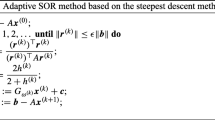Abstract
The theoretical basis for a new optimality criteria method (DCOC) was presented in Part I of this study (Zhou and Rozvany 1992). It was shown in that paper that a considerable gain in efficiency can be achieved by the proposed method, since the Lagrangian multipliers associated with stress constraints can be, in general, evaluated explicitly and hence the size of the dualtype problem is greatly reduced. The superior efficiency of the proposed method, for problems involving a large number of active stress constraints, was also demonstrated through simple numerical examples. In Part II, the computational algorithm of DCOC is presented in detail and several standard test examples are used for verifying the correctness and efficiency of the proposed method.
Similar content being viewed by others
References
Berke, L. 1970: An efficient approach to the minimum weight design of deflection limited structures.Rep. Air Force Flight Dynamics Lab., AFFDL-TM-70-4, Ohio, USA
Berke, L.; Khot, N.S. 1974: Use of optimality criteria methods for large scale systems.Structural optimization, AGARD Lecture Series No. 70, 1–29
Fleury, C. 1979: A unified approach to structural weight minimization.Comp. Meth. Appl. Mech. Engrg. 14, 1761–1783
Fleury, C. 1982: Reconciliation of mathematical programming and optimality criteria methods. In: Morris, A.J. (ed.)Foundations of structural optimization: a unified approach, pp. 363–404. Chichester: Wiley & Sons
Fleury, C; Schmit, L.A. 1980: Structural synthesis by combining approximation concepts and dual methods.AIAA J. 18, 1252–1260
Gill, P.E.; Murray, W. 1974: Newton-type methods for unconstrained and linearly constrained optimization.Mathematical Programming 7, 311–350
Haftka, R.T.; Gürdal, Z.; Kamat, K.P. 1990:Elements of structural optimization. Dordrecht: Kluwer
Khot, N.S. 1981: Algorithms based on optimality criteria to design minimum weight structures.Eng. Opt. 5, 73–90
Thomas, H.L.; Vanderplaats, G.N.; Shyy, Y.K. 1992: A study of move limit adjustment strategies in the approximation concepts approach to structural synthesis.Proc. 4-th AIAA/USAF/NASA/OAI Symp. on Multidisciplinary Analysis and Optimization (held in Cleveland, OH), pp. 507–512
Venkayya, V.B.; Khot, N.S.; Berke, L. 1973: Application of optimality criteria approaches on automated design of large practical structures.AGARD CP-123
Zhou, M.; Haftka, R.T. 1994: A comparison study of optimality criteria methods.Proc. 35th AIAA/ASME/ASCE/AHS/ASC SDM Conf. (held in South Carolina, April 1994) (to appear)
Zhou, M.; Rozvany, G.I.N. 1992: DCOC: an optimality criteria method for large systems, Part I: theory.Struct. Optim. 5, 12–25
Zhou, M.; Rozvany, G.I.N. 1993: DCOC method for sizing structures with complex cross-sections. In: Herskovits, J. (ed.)Proc. World Cong. on Optimal Design of Structural Systems (held in Rio de Janeiro, Brazil, 1993)
Zhou, M.; Rozvany, G.I.N. 1994: An improved approximation technique for the DCOC method of sizing optimization.Int. J. Num. Meth. Engrg. (to be submitted)
Author information
Authors and Affiliations
Rights and permissions
About this article
Cite this article
Zhou, M., Rozvany, G.I.N. DCOC: An optimality criteria method for large systems Part II: Algorithm. Structural Optimization 6, 250–262 (1993). https://doi.org/10.1007/BF01743384
Received:
Issue Date:
DOI: https://doi.org/10.1007/BF01743384




